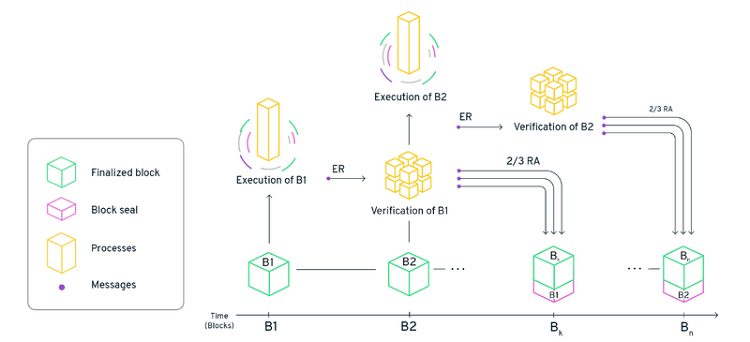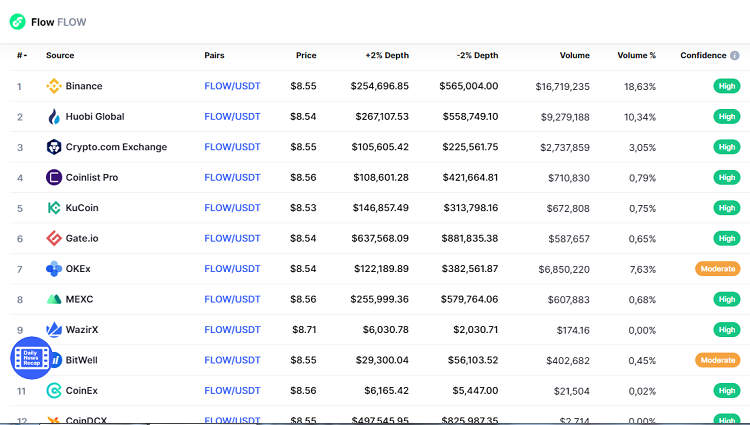Ranked among the top 100 digital currencies with the largest market capitalization among tens of thousands of different cryptocurrencies emerging like mushrooms. The FLOW coin is also considered one of the cryptocurrencies that have received attention from the community. So, what is FLOW coin, what are the pros and cons of the FLOW project, and should you invest or not, please see the detailed analysis right after this.
Contents
- 1 What is FLOW coin, should you invest?
What is FLOW coin, should you invest?

What is FLOW network?
The history of the Flow blockchain started incidentally on Ethereum. Going back to 2017, Dapper Labs created CryptoKitties – the world’s first widely applied blockchain game. CryptoKitties focused on collecting and breeding digital cats. At the time of its release on Ethereum, CryptoKitties became so popular that it essentially brought down the Ethereum network. Due to the overwhelming volume of activities related to CryptoKitties, transactions on the Ethereum platform were almost halted, taking many days and exorbitant gas fees to resolve.This failure led Dapper Labs developers to dream of their own ideal blockchain for games and cryptocurrencies. The new blockchain would need to be scalable to avoid network congestion like Ethereum and transactions also need to have low gas fees even with a high volume of transactions.
Dapper Labs introduced their FLOW blockchain in an $18 million public sale on CoinList. Since then, the Flow ecosystem has grown to include partners like NBA Top Shot, UFC, NFL, Samsung, Google, MotoGP, and Ubisoft.
Flow is built to be fast, scalable, and developer-friendly. The goal of Flow is to become the default platform for NFT applications, gaming applications, and Decentralized Autonomous Organizations (DAOs).
Who created the FLOW Blockchain?

As mentioned above, the FLOW network was created by Dapper Labs, and the key members of Dapper Labs include:
-
Roham Gharegozlou: CEO of Dapper Labs, founder of CryptoKitties, Flow, and NBA Top Shot. He holds a bachelor’s degree in Economics and a master’s degree in Biological Sciences from Stanford University. Before Dapper Labs, Roham was also the founder and CEO of Axiom Zen.
-
Dieter “dete” Shirley: Co-founder and CTO of the FLOW blockchain project, co-founder of CryptoKitties, and the author of the ERC-721 proposal defining non-fungible tokens on Ethereum, senior software engineer at Apple and Head of Development at Atimi.
-
Mikhael Naayem: Chief Business Officer at Dapper Labs, Board Member at Axiom Zen. Mik is also the founder and CEO of Fuel, a platform he grew to over 225 million users before selling to Animoca in 2017.
-
Alex Shih: Alex is the CFO at Axiom Zen and Dapper Labs and leads the strategic finance function. He holds a B.S. and M.S. in Management Science & Engineering from Stanford University.
In addition, the FLOW project development team includes many members with deep knowledge and extensive experience working in large technology corporations around the world. You can see more details on the project’s website for more information.
What is FLOW coin?
Basic information about FLOW token:
- Blockchain: FLOW
- Trading code: FLOW
- Total maximum supply: unlimited
- Circulating supply: 1,574,016,688
- Market capitalization: $ 581.78 M
What makes FLOW’s technology stand out?
To achieve the goals set out by the project, the FLOW development team has applied the following standout technologies:
Multi-role architecture
With early-generation blockchains, each node stores the entire state (account balances, smart contract code, etc.) and performs all the work related to processing each transaction in the chain. This is like having one person make an entire car.
Flow does not do this but instead divides the work of a validator node into four different roles: Collection, Consensus, Execution, and Verification. This division of labor among nodes vertically (through different confirmation stages for each transaction) rather than horizontally (across different transactions, as with sharding).
In other words, each validator node still participates in confirming each transaction, but only in one of the stages of confirmation. This increases efficiency in transaction processing, expands throughput, and reduces costs.

Resource-oriented programming
Smart contracts on FLOW are written in Cadence, a programming language that is easier and safer for cryptocurrency assets and applications. With FLOW, smart contracts can be upgraded.
Developer ergonomics
Helps upgrade smart contracts (Smart Contract) supporting integrated logging to the FLOW Emulator.
Consumer onboarding
Flow is designed for the general consumer, with tools to support safe payments, easy conversion from fiat currency to cryptocurrency.
Proof of Stake (PoS) consensus algorithm
Compared to the POW (Proof of Work) algorithm of Ethereum or Bitcoin, the PoS algorithm will reduce energy consumption and offer cheaper gas fees. PoS determines who verifies the next block.
PoS is an improved algorithm compared to POW, being faster, cheaper, and many blockchains today are applying it.
Comparing FLOW and Ethereum
Đặc điểm so sánh | FLOW | ETHEREUM |
Scalability | Very fast, aiming to achieve 10,000 transactions per second. | Scalability is quite challenging with only 13 to 15 transactions per second. |
Transaction Fees | Account creation fee is about 0.001 FLOW and transaction fees are very low at approximately 0.000001 FLOW. | Depends on network congestion and complexity of smart contracts. Typically around $20. |
Account Model | Automatically created by the blockchain and supports multiple public keys. | Accounts are created based on a single Private key. |
Consensus Mechanism | Proof of Stake (POS) | Proof of Stake (POS) |
Should You Invest in FLOW Coin?
To determine whether to invest in FLOW coin or not, let’s analyze its advantages and disadvantages.
What are the advantages of FLOW coin?
♥ The project development team has extensive experience and knowledge in Blockchain technology.
♥ The platform is built with a good concept, very fast transaction processing speed, low gas fees, and scalability.
♥ Google Cloud announced a partnership with Dapper Labs – the development team of the FLOW project.
♥ Over 600 projects are being developed on the FLOW platform, with 175,000 users each month, over 5000 developers building projects on FLOW, and over 350 Network Nodes…
♥ FLOW is widely used in transactions and system operations, unlike some other coins that are only used for governance purposes.
What are the disadvantages of FLOW coin?
♦ The price fluctuates according to Bitcoin and the cryptocurrency market, with high risk.
♦ Unlimited supply and annual inflation, so it cannot rely on the scarcity of supply to increase FLOW’s value.
♦ Faces a lot of competition from other cryptocurrency projects with similar features like Solana, Cosmos, Polkadot, Avalanche…
♦ Uses a new programming language, so developers wanting to develop have to learn from scratch.
♦ Being a relatively new project, it is uncertain what its future will be.
Where to Buy FLOW Coin, Which Are Reliable Exchanges?

Which Wallets to Store FLOW Coin?
Currently, FLOW coin is not linked with many wallets but only with Blocto wallet or Ledger wallet. Blocto wallet is less used while Ledger wallet is more reputable, used by more people, and can store various types of coins, so it is a better option.
– FLOW is a blockchain platform with scalability, fast transaction processing, and much lower costs compared to Bitcoin or Ethereum.
– FLOW was created to develop an ecosystem for decentralized games, Dapps, NFTs, and digital assets in a decentralized manner.
– The development team of FLOW coin is skilled, experienced in Blockchain technology and proficient in technical aspects.
– Currently, FLOW coin is priced at $ 0.370421, with a market cap of $ 581.78 M, ranking in market cap at 121
See more related useful information:
- What is CKB token? Is Nervos Network (CKB) a good investment?
- 50+ Famous Crypto Quotes from Big Investors in the World
















